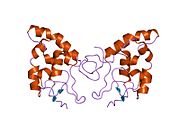Frizzled-8
| FZD8 | |||||||||||||||||||||||||||||||||||||||||||||||||||
|---|---|---|---|---|---|---|---|---|---|---|---|---|---|---|---|---|---|---|---|---|---|---|---|---|---|---|---|---|---|---|---|---|---|---|---|---|---|---|---|---|---|---|---|---|---|---|---|---|---|---|---|
 | |||||||||||||||||||||||||||||||||||||||||||||||||||
| |||||||||||||||||||||||||||||||||||||||||||||||||||
| Identifiers | |||||||||||||||||||||||||||||||||||||||||||||||||||
| Aliases | FZD8, FZ-8, hFZ8, frizzled class receptor 8 | ||||||||||||||||||||||||||||||||||||||||||||||||||
| External IDs | OMIM: 606146; MGI: 108460; HomoloGene: 40606; GeneCards: FZD8; OMA:FZD8 - orthologs | ||||||||||||||||||||||||||||||||||||||||||||||||||
| |||||||||||||||||||||||||||||||||||||||||||||||||||
| |||||||||||||||||||||||||||||||||||||||||||||||||||
| |||||||||||||||||||||||||||||||||||||||||||||||||||
| |||||||||||||||||||||||||||||||||||||||||||||||||||
| |||||||||||||||||||||||||||||||||||||||||||||||||||
| Wikidata | |||||||||||||||||||||||||||||||||||||||||||||||||||
| |||||||||||||||||||||||||||||||||||||||||||||||||||
Frizzled-8 (Fz-8) is a protein that in humans is encoded by the FZD8 gene.[5][6]
Function
This intronless gene is a member of the frizzled gene family. Members of this family encode seven-transmembrane domain proteins that are receptors for the Wingless type MMTV integration site family of signaling proteins. Most frizzled receptors are coupled to the beta-catenin canonical signaling pathway. This gene is highly expressed in two human cancer cell lines, indicating that it may play a role in several types of cancer. The crystal structure of the extracellular cysteine-rich domain of a similar mouse protein has been determined.[6]
References
- ^ a b c GRCh38: Ensembl release 89: ENSG00000177283 – Ensembl, May 2017
- ^ a b c GRCm38: Ensembl release 89: ENSMUSG00000036904 – Ensembl, May 2017
- ^ "Human PubMed Reference:". National Center for Biotechnology Information, U.S. National Library of Medicine.
- ^ "Mouse PubMed Reference:". National Center for Biotechnology Information, U.S. National Library of Medicine.
- ^ Saitoh T, Hirai M, Katoh M (Apr 2001). "Molecular cloning and characterization of human Frizzled-8 gene on chromosome 10p11.2". Int J Oncol. 18 (5): 991–6. doi:10.3892/ijo.18.5.991. PMID 11295046.
- ^ a b "Entrez Gene: FZD8 frizzled homolog 8 (Drosophila)".
Further reading
- Wang Y, Macke JP, Abella BS, Andreasson K, Worley P, Gilbert DJ, Copeland NG, Jenkins NA, Nathans J (1996). "A large family of putative transmembrane receptors homologous to the product of the Drosophila tissue polarity gene frizzled". J. Biol. Chem. 271 (8): 4468–4476. doi:10.1074/jbc.271.8.4468. PMID 8626800.
- Finch PW, He X, Kelley MJ, Uren A, Schaudies RP, Popescu NC, Rudikoff S, Aaronson SA, Varmus HE, Rubin JS (1997). "Purification and molecular cloning of a secreted, Frizzled-related antagonist of Wnt action". Proc. Natl. Acad. Sci. U.S.A. 94 (13): 6770–6775. Bibcode:1997PNAS...94.6770F. doi:10.1073/pnas.94.13.6770. PMC 21233. PMID 9192640.
- Tamai K, Semenov M, Kato Y, Spokony R, Liu C, Katsuyama Y, Hess F, Saint-Jeannet JP, He X (2000). "LDL-receptor-related proteins in Wnt signal transduction". Nature. 407 (6803): 530–535. Bibcode:2000Natur.407..530T. doi:10.1038/35035117. PMID 11029007. S2CID 4400159.
- Hartley JL, Temple GF, Brasch MA (2001). "DNA cloning using in vitro site-specific recombination". Genome Res. 10 (11): 1788–1795. doi:10.1101/gr.143000. PMC 310948. PMID 11076863.
- Semënov MV, Tamai K, Brott BK, Kühl M, Sokol S, He X (2001). "Head inducer Dickkopf-1 is a ligand for Wnt coreceptor LRP6". Curr. Biol. 11 (12): 951–961. Bibcode:2001CBio...11..951S. doi:10.1016/S0960-9822(01)00290-1. PMID 11448771. S2CID 15702819.
- Dann CE, Hsieh JC, Rattner A, Sharma D, Nathans J, Leahy DJ (2001). "Insights into Wnt binding and signalling from the structures of two Frizzled cysteine-rich domains". Nature. 412 (6842): 86–90. Bibcode:2001Natur.412...86D. doi:10.1038/35083601. PMID 11452312. S2CID 4303237.
- Yao R, Maeda T, Takada S, Noda T (2001). "Identification of a PDZ domain containing Golgi protein, GOPC, as an interaction partner of frizzled". Biochem. Biophys. Res. Commun. 286 (4): 771–778. doi:10.1006/bbrc.2001.5430. PMID 11520064.
- Omoto S, Hayashi T, Kitahara K, Takeuchi T, Ueoka Y (2004). "Autosomal dominant familial exudative vitreoretinopathy in two Japanese families with FZD4 mutations (H69Y and C181R)". Ophthalmic Genet. 25 (2): 81–90. doi:10.1080/13816810490514270. PMID 15370539. S2CID 32817238.
- Lu W, Yamamoto V, Ortega B, Baltimore D (2004). "Mammalian Ryk is a Wnt coreceptor required for stimulation of neurite outgrowth". Cell. 119 (1): 97–108. doi:10.1016/j.cell.2004.09.019. PMID 15454084. S2CID 18567677.
External links
- "Frizzled Receptors: FZD8". IUPHAR Database of Receptors and Ion Channels. International Union of Basic and Clinical Pharmacology. Archived from the original on 2014-09-03. Retrieved 2008-12-04.
- Overview of all the structural information available in the PDB for UniProt: Q9H461 (Human Frizzled-8 (FZD8)) at the PDBe-KB.
- v
- t
- e
-
 1ijy: CRYSTAL STRUCTURE OF THE CYSTEINE-RICH DOMAIN OF MOUSE FRIZZLED 8 (MFZ8)
1ijy: CRYSTAL STRUCTURE OF THE CYSTEINE-RICH DOMAIN OF MOUSE FRIZZLED 8 (MFZ8)
This article incorporates text from the United States National Library of Medicine, which is in the public domain.
 | This transmembrane receptor-related article is a stub. You can help Wikipedia by expanding it. |
- v
- t
- e



















